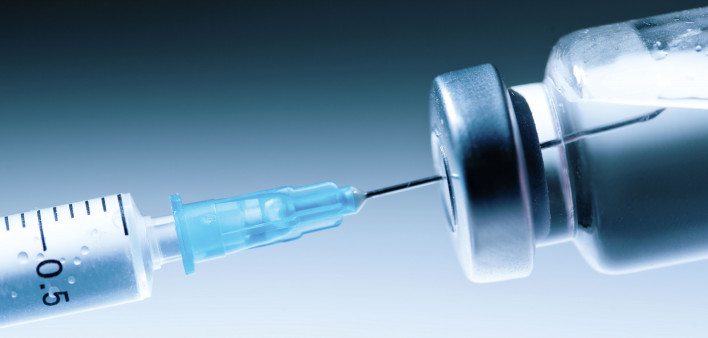A new experimental HIV vaccine that uses the same messenger RNA (mRNA) technology as highly effective COVID-19 vaccines lowered the likelihood that monkeys would become infected with an HIV-like virus by 79%, according to study results published in Nature Medicine.
“Despite nearly four decades of effort by the global research community, an effective vaccine to prevent HIV remains an elusive goal,” National Institute of Allergy and Infectious Diseases (NIAID) director Anthony Fauci, MD, one of the study’s coauthors, said in a press release. “This experimental mRNA vaccine combines several features that may overcome shortcomings of other experimental HIV vaccines and thus represents a promising approach.”
The quest for an HIV vaccine has led to years of disappointment as one approach after another has failed to protect people from acquiring the virus. Unlike SARS-CoV-2—the coronavirus that causes COVID-19—HIV mutates rapidly and is able to hide from the immune system, making vaccine development more challenging. Vaccines that administer HIV proteins in an effort to stimulate an immune response have demonstrated little success.
The new vaccine being developed by researchers at NIAID and Moderna takes a different approach. Instead of directly injecting HIV proteins or using a viral vector to deliver them, it uses messenger RNA encoding genetic blueprints that instruct cells to make these proteins and assemble them into virus-like particles (VLPs) that can trigger an immune response. Specifically, the vaccine administers instructions for making envelope proteins from three clades, or types, of HIV found in different parts of the world plus Gag proteins from SIV, a related virus that infects monkeys. The resulting VLPs look like HIV or SIV to the immune system, but they do not contain the full viral genetic code and cannot cause disease.
Paolo Lusso, MD, PhD, of NIAID, and colleagues evaluated the mRNA vaccine approach in mice and monkeys. Early study findings were previously presented at the 2020 International AIDS Conference and the 2021 Conference on Retroviruses and Opportunistic Infections.
In studies of mice, two injections of the mRNA vaccine led to the expression of envelope proteins that closely resemble those of the whole HIV virus and stimulated production of neutralizing antibodies. These antibodies, which recognize “conserved” regions of the viral envelope that differ little among HIV strains, can prevent the virus from entering cells. Adding Gag mRNA worked better than using envelope proteins alone.
“The display of multiple copies of authentic HIV envelope protein on each VLP is one of the special features of our platform that closely mimics natural infection and may have played a role in eliciting the desired immune responses,” Lusso said.
The researchers then tested a variety of vaccine regimens in rhesus macaque. The monkeys received primer vaccines containing mRNA that encodes envelope proteins from HIV clade B (the most common type in the United States and Europe), followed by multiple boosters over the course of a year that encode envelope proteins from two other types of HIV (clades A and C, which are predominant in Africa). Some also received a booster containing stabilized HIV spike proteins, known as SOSIP trimers, that are more easily recognized by broadly neutralizing antibodies.
By week 58, all vaccinated monkeys had measurable levels of neutralizing antibodies against most of the 12 tested strains of HIV. Antibodies against clade B proteins emerged first and were strongest, but ultimately, cross-neutralizing antibodies against the other clades were also seen. What’s more, the vaccines also induced robust helper T-cell responses.
The vaccine regimens were was safe and well tolerated with only mild, temporary side effects, such as loss of appetite.
Starting at week 60, the vaccinated macaques and a control group of unvaccinated monkeys were rectally exposed to a potent hybrid HIV-SIV virus once weekly, in an effort to mimic sexual exposure. (Macaques are not susceptible to HIV itself.) After 13 weekly exposures, two of the seven vaccinated monkeys remained uninfected—reflecting a 79% per-exposure risk reduction—and the others had delayed infection, occurring after an average of eight weeks. The unvaccinated monkeys, in contrast, became infected after an average of three weeks.
Although the protective effect of the vaccine was partial, the study authors noted that sexual transmission of HIV in humans is inefficient, and even this level of risk reduction “might still have a significant impact on viral transmission.”
The researchers also acknowledged that while the intensive high-dose immunization schedule was “remarkably well tolerated,” a vaccination regimen that requires seven or more shots would be “difficult to implement in humans.” Thus, they are working to improve the vaccine to generate more and better VLPs, which could reduce the number of boosters needed.
“We are now refining our vaccine protocol to improve the quality and quantity of the VLPs produced. This may further increase vaccine efficacy and thus lower the number of prime and boost inoculations needed to produce a robust immune response,“ Lusso said. ”If confirmed safe and effective, we plan to conduct a Phase I trial of this vaccine platform in healthy adult volunteers."
Another collaboration that includes the International AIDS Vaccine Initiative and Moderna is working on a different mRNA vaccine approach, known as germline targeting, that aims to train immature B cells in a stepwise fashion to generate broadly neutralizing antibodies against HIV.
Click here to learn more about the challenges of HIV vaccine research.







Comments
Comments